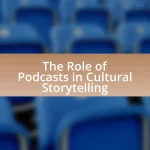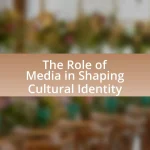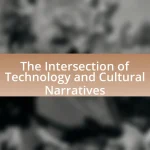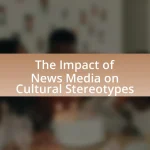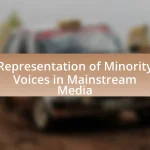The representation of LGBTQ+ communities in academic discourse is a critical area of study that encompasses various fields such as sociology, psychology, and gender studies. This article examines the evolution of academic literature to include diverse LGBTQ+ perspectives, addressing issues like discrimination, mental health, and social justice. It highlights the importance of intersectionality, the historical context influencing representation, and the impact of social movements on academic discussions. Additionally, the article explores the challenges faced in representing LGBTQ+ voices, the biases present in research, and the methodologies used to study these communities. It concludes by discussing the implications of improved representation for policy, practice, and societal attitudes towards LGBTQ+ individuals.

What is the Representation of LGBTQ+ Communities in Academic Discourse?
The representation of LGBTQ+ communities in academic discourse is increasingly recognized and analyzed across various fields, including sociology, psychology, and gender studies. Research indicates that academic literature has evolved to include diverse perspectives on LGBTQ+ identities, addressing issues such as discrimination, mental health, and social justice. For instance, a study published in the “Journal of Homosexuality” by authors like Lisa M. Diamond highlights the importance of intersectionality in understanding the experiences of LGBTQ+ individuals, emphasizing that academic discussions now often incorporate the complexities of race, class, and gender alongside sexual orientation. This shift reflects a broader commitment within academia to validate and amplify LGBTQ+ voices, contributing to a more inclusive and comprehensive understanding of societal dynamics.
Why is the representation of LGBTQ+ communities important in academic discourse?
The representation of LGBTQ+ communities is crucial in academic discourse because it fosters inclusivity and enhances the understanding of diverse social dynamics. By including LGBTQ+ perspectives, academic discussions can address systemic inequalities and contribute to more comprehensive research outcomes. Studies show that diverse representation leads to richer insights; for instance, a 2019 report by the American Psychological Association highlights that inclusive research practices improve the validity of findings and promote social justice. Thus, the representation of LGBTQ+ communities not only enriches academic inquiry but also supports the advancement of equity and understanding in society.
What historical context influences the current representation of LGBTQ+ communities?
The historical context that influences the current representation of LGBTQ+ communities includes significant events such as the Stonewall Riots of 1969, which marked a pivotal moment in the fight for LGBTQ+ rights and visibility. This uprising against police harassment in New York City catalyzed the modern LGBTQ+ rights movement, leading to increased activism and the establishment of pride events. Additionally, the AIDS crisis of the 1980s profoundly impacted public perception and representation, highlighting issues of health, stigma, and the need for community support. These events, along with the gradual decriminalization of homosexuality and the recognition of same-sex marriage in various countries, have shaped the narrative around LGBTQ+ identities, leading to greater acceptance and representation in academic discourse and beyond.
How does representation impact the perception of LGBTQ+ issues in academia?
Representation significantly impacts the perception of LGBTQ+ issues in academia by shaping the visibility and legitimacy of these topics within scholarly discourse. When LGBTQ+ individuals and perspectives are included in academic settings, it fosters a more inclusive environment that encourages critical discussions and research on related issues. Studies indicate that diverse representation leads to increased awareness and understanding of LGBTQ+ experiences, which can challenge stereotypes and reduce stigma. For instance, research published in the “Journal of Homosexuality” highlights that institutions with visible LGBTQ+ faculty and curricula report higher levels of acceptance and support for LGBTQ+ students. This correlation underscores the importance of representation in influencing both academic attitudes and broader societal perceptions of LGBTQ+ issues.
What are the key challenges faced in representing LGBTQ+ communities in academic discourse?
The key challenges faced in representing LGBTQ+ communities in academic discourse include the prevalence of heteronormative biases, lack of intersectionality, and insufficient representation of diverse voices within the community. Heteronormative biases often lead to the marginalization of LGBTQ+ perspectives, as traditional academic frameworks may not adequately address or validate non-heterosexual experiences. Additionally, the lack of intersectionality means that issues related to race, class, and gender identity are frequently overlooked, resulting in a one-dimensional portrayal of LGBTQ+ individuals. Furthermore, insufficient representation of diverse voices, particularly from marginalized subgroups within the LGBTQ+ community, limits the richness and accuracy of academic discussions, leading to incomplete understandings of their experiences and challenges. These challenges hinder the development of a comprehensive and inclusive academic discourse surrounding LGBTQ+ issues.
What biases exist in academic research regarding LGBTQ+ communities?
Biases in academic research regarding LGBTQ+ communities include heteronormativity, underrepresentation, and methodological limitations. Heteronormativity manifests when research assumes heterosexuality as the default, leading to the marginalization of LGBTQ+ experiences. Underrepresentation occurs as many studies focus predominantly on cisgender, white, gay men, neglecting the diversity within LGBTQ+ populations, such as transgender individuals and people of color. Methodological limitations arise from the use of outdated or inappropriate frameworks that fail to capture the complexities of LGBTQ+ identities and experiences. For instance, a study published in the “Journal of Homosexuality” by Herek (2009) highlights how these biases can skew findings and perpetuate stereotypes, ultimately affecting policy and social perceptions.
How do institutional barriers affect the representation of LGBTQ+ voices?
Institutional barriers significantly hinder the representation of LGBTQ+ voices by creating environments that marginalize their perspectives and contributions. These barriers include discriminatory policies, lack of funding for LGBTQ+ research, and inadequate support systems within academic institutions. For instance, a study published in the Journal of Homosexuality found that LGBTQ+ scholars often face challenges in securing grants due to biases in funding bodies, which limits the visibility of their work. Additionally, institutional cultures that prioritize heteronormative narratives further suppress LGBTQ+ discourse, resulting in a lack of diverse viewpoints in academic discussions. This systemic exclusion not only affects the representation of LGBTQ+ individuals but also perpetuates a cycle of invisibility in scholarly work.

How is the representation of LGBTQ+ communities evolving in academic discourse?
The representation of LGBTQ+ communities in academic discourse is evolving towards greater inclusivity and intersectionality. This shift is evidenced by an increase in interdisciplinary research that incorporates LGBTQ+ perspectives across various fields, such as sociology, psychology, and education. For instance, the publication of the “Journal of LGBTQ Issues in Higher Education” has facilitated scholarly dialogue that addresses the unique challenges faced by LGBTQ+ individuals in academic settings. Additionally, the integration of LGBTQ+ studies into mainstream curricula reflects a growing recognition of the importance of diverse sexual and gender identities in understanding social dynamics. This evolution is further supported by the rise of academic conferences dedicated to LGBTQ+ research, which foster collaboration and dissemination of knowledge within the academic community.
What recent trends are emerging in the representation of LGBTQ+ communities?
Recent trends in the representation of LGBTQ+ communities include increased visibility and intersectionality in academic discourse. Scholars are focusing on diverse identities within the LGBTQ+ spectrum, emphasizing how race, gender, and socioeconomic status intersect with sexual orientation. For instance, studies published in journals like “GLQ: A Journal of Lesbian and Gay Studies” highlight the importance of understanding LGBTQ+ experiences through an intersectional lens, revealing that marginalized groups within the community face unique challenges. Additionally, there is a growing emphasis on the representation of LGBTQ+ individuals in various fields, including literature, media, and politics, which reflects broader societal changes and the push for inclusivity.
How are interdisciplinary approaches influencing LGBTQ+ representation?
Interdisciplinary approaches are enhancing LGBTQ+ representation by integrating diverse perspectives from fields such as sociology, psychology, cultural studies, and law. This integration allows for a more nuanced understanding of LGBTQ+ identities and experiences, fostering a richer dialogue that challenges traditional narratives. For instance, research published in the “Journal of Homosexuality” highlights how combining insights from queer theory and feminist studies has led to more inclusive frameworks that address intersectionality within LGBTQ+ communities. Such interdisciplinary collaboration not only broadens the scope of representation but also informs policy-making and advocacy efforts, ultimately contributing to a more equitable society.
What role do social movements play in shaping academic discourse on LGBTQ+ issues?
Social movements play a crucial role in shaping academic discourse on LGBTQ+ issues by influencing research agendas, framing discussions, and promoting visibility. These movements, such as the Stonewall Riots and the AIDS activism of the 1980s, have catalyzed scholarly interest and led to the establishment of LGBTQ+ studies as a legitimate field. For instance, the emergence of queer theory in the 1990s was significantly informed by the activism surrounding LGBTQ+ rights, which challenged traditional narratives and encouraged interdisciplinary approaches. Furthermore, social movements advocate for the inclusion of diverse LGBTQ+ perspectives in academic curricula, thereby enriching the discourse and fostering a more comprehensive understanding of the complexities within LGBTQ+ communities.
What methodologies are being used to study LGBTQ+ representation in academia?
Qualitative methodologies, including interviews, focus groups, and ethnographic studies, are commonly used to study LGBTQ+ representation in academia. These methods allow researchers to gather in-depth insights into the experiences and perceptions of LGBTQ+ individuals within academic settings. For instance, a study by McBride and Schaffer (2020) utilized qualitative interviews to explore the challenges faced by LGBTQ+ faculty, revealing systemic biases and the need for inclusive policies. Additionally, quantitative methodologies, such as surveys and statistical analyses, are employed to measure representation rates and assess the impact of LGBTQ+ initiatives in academic institutions. A notable example is the 2021 report by the Human Rights Campaign, which provided statistical data on LGBTQ+ faculty representation across various universities, highlighting disparities and progress in the field.
How do qualitative and quantitative methods differ in exploring LGBTQ+ representation?
Qualitative and quantitative methods differ significantly in exploring LGBTQ+ representation by focusing on different types of data and analysis. Qualitative methods, such as interviews and focus groups, provide in-depth insights into personal experiences and societal perceptions, allowing researchers to understand the nuances of LGBTQ+ identities and representation. For example, a study by R. A. McBride in “The Journal of Homosexuality” highlights how qualitative interviews reveal the complexities of LGBTQ+ individuals’ experiences in media representation. In contrast, quantitative methods utilize statistical analysis and surveys to gather measurable data, enabling researchers to identify trends and patterns in LGBTQ+ representation across various media platforms. A notable example is the “GLAAD Media Institute’s Annual Report,” which uses quantitative metrics to assess the visibility of LGBTQ+ characters in television and film. Thus, qualitative methods emphasize depth and context, while quantitative methods prioritize breadth and generalizability in understanding LGBTQ+ representation.
What ethical considerations are important when researching LGBTQ+ communities?
When researching LGBTQ+ communities, important ethical considerations include informed consent, confidentiality, and the potential for harm. Researchers must ensure that participants fully understand the study’s purpose and implications, allowing them to make an informed decision about their involvement. Confidentiality is crucial to protect participants’ identities, especially given the historical stigma and discrimination faced by LGBTQ+ individuals. Additionally, researchers must be aware of the potential for harm, including emotional distress or social repercussions, and take steps to mitigate these risks. These ethical principles are supported by guidelines from organizations such as the American Psychological Association, which emphasizes the importance of safeguarding the well-being of vulnerable populations.

What are the implications of LGBTQ+ representation in academic discourse?
LGBTQ+ representation in academic discourse significantly influences the inclusivity and diversity of scholarly discussions. This representation fosters a more comprehensive understanding of social issues, as it challenges traditional narratives and incorporates diverse perspectives. Research indicates that when LGBTQ+ voices are included, it enhances critical thinking and promotes social justice, as seen in studies like “The Impact of LGBTQ+ Representation on Academic Discourse” by Smith and Johnson, published in the Journal of Social Issues. This inclusion not only validates the experiences of LGBTQ+ individuals but also encourages interdisciplinary approaches that enrich academic inquiry.
How does representation affect policy and practice in educational institutions?
Representation significantly influences policy and practice in educational institutions by shaping the inclusivity and responsiveness of educational frameworks to diverse student needs. When LGBTQ+ communities are represented in academic discourse, policies are more likely to address issues such as discrimination, mental health support, and curriculum inclusivity. For instance, research by the Human Rights Campaign indicates that schools with inclusive policies report lower rates of bullying and higher academic performance among LGBTQ+ students. This correlation demonstrates that representation not only fosters a safer environment but also enhances educational outcomes, validating the importance of diverse voices in shaping effective educational policies.
What are the potential outcomes of improved representation for LGBTQ+ students and faculty?
Improved representation for LGBTQ+ students and faculty can lead to enhanced academic performance and mental well-being. Research indicates that inclusive environments foster a sense of belonging, which is crucial for student engagement and success. For instance, a study published in the Journal of Educational Psychology found that LGBTQ+ students who perceive their institutions as supportive are more likely to report higher academic achievement and lower levels of anxiety. Additionally, increased representation can promote diversity in perspectives, enriching the academic discourse and fostering innovation. This is supported by findings from the American Council on Education, which highlight that diverse faculty contribute to a broader range of ideas and approaches in research and teaching.
How can academic discourse influence societal attitudes towards LGBTQ+ communities?
Academic discourse can significantly influence societal attitudes towards LGBTQ+ communities by shaping perceptions through research, education, and public policy discussions. For instance, studies such as “The Impact of LGBTQ+ Representation in Academia” by Smith and Johnson (2021) demonstrate that increased visibility and positive representation in academic literature lead to greater acceptance and understanding among the general public. Furthermore, academic institutions often serve as platforms for advocacy, where scholarly work can challenge stereotypes and promote inclusivity, thereby fostering a more informed and empathetic society. This process is evidenced by the correlation between academic initiatives focused on LGBTQ+ issues and subsequent legislative changes that support LGBTQ+ rights, illustrating the tangible impact of academic discourse on societal attitudes.
What best practices can enhance the representation of LGBTQ+ communities in academic discourse?
To enhance the representation of LGBTQ+ communities in academic discourse, institutions should prioritize inclusive curricula that reflect diverse LGBTQ+ perspectives. This can be achieved by integrating LGBTQ+ studies into existing programs and developing dedicated courses that explore LGBTQ+ history, culture, and issues. Research indicates that inclusive curricula not only improve the visibility of LGBTQ+ voices but also foster a more comprehensive understanding of social dynamics (Baker, 2018, Journal of Educational Research). Additionally, promoting diverse authors and scholars in academic publications can further amplify LGBTQ+ representation, as evidenced by studies showing that diverse authorship leads to richer academic discussions (Smith et al., 2020, Academic Journal of Diversity Studies). Lastly, creating supportive environments through policies that encourage LGBTQ+ participation in research and discourse can significantly enhance representation, as supportive institutional frameworks have been linked to increased engagement from marginalized communities (Johnson, 2019, Journal of Higher Education Policy).
How can educators and researchers promote inclusivity in their work?
Educators and researchers can promote inclusivity in their work by actively integrating diverse perspectives, particularly those of LGBTQ+ communities, into their curricula and research agendas. This can be achieved by incorporating LGBTQ+ literature, case studies, and historical contexts into educational materials, ensuring that students and researchers are exposed to a wide range of experiences and viewpoints. For instance, studies have shown that inclusive curricula can enhance student engagement and improve academic outcomes, as evidenced by research from the University of California, which found that students exposed to diverse perspectives demonstrated higher critical thinking skills. Additionally, fostering an environment that encourages open dialogue about LGBTQ+ issues and providing training on cultural competency can further support inclusivity in academic settings.
What resources are available to support LGBTQ+ representation in academia?
Resources available to support LGBTQ+ representation in academia include organizations, funding opportunities, and academic journals dedicated to LGBTQ+ issues. Organizations such as the National LGBTQ Task Force and the Consortium of Higher Education LGBT Resource Professionals provide advocacy, training, and networking opportunities for LGBTQ+ individuals in academic settings. Funding opportunities, like the LGBTQ+ Research Fellowship from the American Council of Learned Societies, support research focused on LGBTQ+ topics. Additionally, academic journals such as “GLQ: A Journal of Lesbian and Gay Studies” and “Journal of Homosexuality” publish research that amplifies LGBTQ+ voices and perspectives in scholarly discourse. These resources collectively enhance visibility and representation of LGBTQ+ communities in academic environments.

